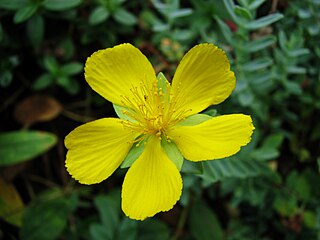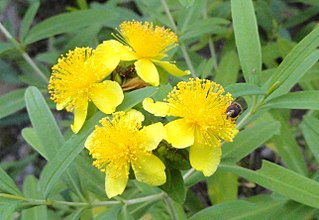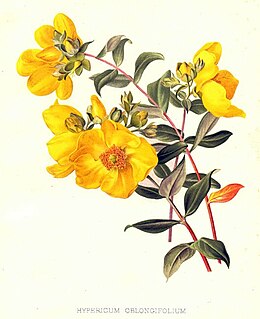
Hypericum perforatum, known as perforate St John's-wort, is a flowering plant in the family Hypericaceae and the type species of the genus Hypericum.

Hypericum is a genus of flowering plants in the family Hypericaceae. The genus has a nearly worldwide distribution, missing only from tropical lowlands, deserts and polar regions. Many Hypericum species are regarded as invasive species and noxious weeds. All members of the genus may be referred to as St. John's wort, and some are known as goatweed. The white or pink flowered marsh St. John's worts of North American and eastern Asia are now separated into the genus Triadenum.

Hypericum calycinum is a species of prostrate or low-growing shrub in the flowering plant family Hypericaceae. Widely cultivated for its large yellow flowers, its names as a garden plant include Rose-of-Sharon in Britain and Australia, and Aaron's beard, great St-John's wort, creeping St. John's wort and Jerusalem star. Grown in Mediterranean climates, widely spread in the Strandja Mountains along the Bulgarian and Turkish Black Sea coast, and also in Flanders in Belgium.

Hypericum concinnum is a species of flowering plant known as gold-wire or goldwire. It is in the St. John's wort family, Hypericaceae. It is the only species in the section Hypericum sect. Concinna.

Hypericum maculatum, commonly known as imperforate St John's-wort, or spotted St. Johnswort, is a species of perennial herbaceous flowering plant in the family Hypericaceae. It is native to Europe and Western Asia where it grows in moist meadows.

Hypericum olympicum, commonly known as the Mount Olympus St. John's wort, is a species of flowering plant in the family Hypericaceae found in the Balkans and Turkey and introduced to western Europe. It has been widely cultivated for centuries because of its large, showy flowers, which are far larger than those of most other species in Hypericum.

Hypericum aegypticum, also known as Egyptian Saint John's wort, is an evergreen shrub or shrublet in the section Adenotrias of the genus Hypericum. Less frequently, dwarf Saint John's wort is used as an alternate name.

Hypericum ascyron, the great St. Johnswort or giant St. John's wort is a flowering plant in the family Hypericaceae.

Hypericum kalmianum, commonly called Kalm's St. Johns wort or Kalm's St. Johnswort, is a flowering plant in the St. John's wort family Hypericaceae. It is native to the Great Lakes region in the northern United States and southern Canada. Hypericum kalmianum was named after its discoverer, Swedish botanist Pehr Kalm (1715-1779).

Hypericeae is a tribe of the Hypericaceae family that contains the genera Hypericum, Thornea, and Lianthus. It was first described by Jacques Choisy, a Swiss botanist, in 1821 in the 32nd issue of Prodr. Monogr. Hypėric.. It was also later described by Adolf Engler in 1895 in the Prantl, Nat. Pflanzenfam.

Hypericum cerastioides is a species of perennial flowering plant in the St. John's wort family, Hypericaceae. It is the only species in the section Hypericum sect. Campylopus.

Hypericum lancasteri, known as Lancaster's St. John's wort or as zhan e jin si tao in Chinese, is a species of flowering plant in the St. John's wort family Hypericaceae. The species has been awarded the Royal Horticultural Society's Award of Garden Merit.
Hypericum assamicum is a species of flowering plant in the St. John's wort family, Hypericaceae. It is endemic to India. Hypericum assamicum is one of two species of Hypericum in the section Hypericum sect. Sampsonia.

Hypericum oblongifolium, known as Pendant St. John's wort, is a species of flowering plant in Hypericumsect. Ascyreia.

Hypericum gymnanthum, the small-flowered St. John's wort or clasping leaf St. John's wort, is a species of flowering plant in the St. John's wort family Hypericaceae native to wet woods, bogs, and ditches of the eastern United States and Guatemala. It has been introduced to Poland.

Hypericum huber-morathii is a flowering plant in the family Hypericaceae, section Adenosepalum, and the type species of the Hypericum huber-morathii group.

Hypericum virginicum, the marsh St. Johns-wort or Virginia marsh St. Johnswort, is a species of flowering plant in the family Hypericaceae. It is native to the central and eastern United States and eastern Canada.
Hypericum fissurale, known as cracked St. John's wort, is a flowering plant in the St. Johns's wort family (Hypericaceae) endemic to northeastern Turkey. It is considered critically endangered on the IUCN Red List due to its very limited distribution and declining population. It was first formally named by Jurij Nikolaewitch Woronow in 1912. It is a small perennial herb in the section Hypericum sect. Taeniocarpium, reaching around 22 cm (8.7 in) in height. Like most Hypericum species, it has flowers with five yellow petals and numerous stamens. Hypericum fissurale is closely related to Hypericum armenum.
Hypericum minutum is a flowering plant in the genus Hypericum, sect. Adenosepalum.















